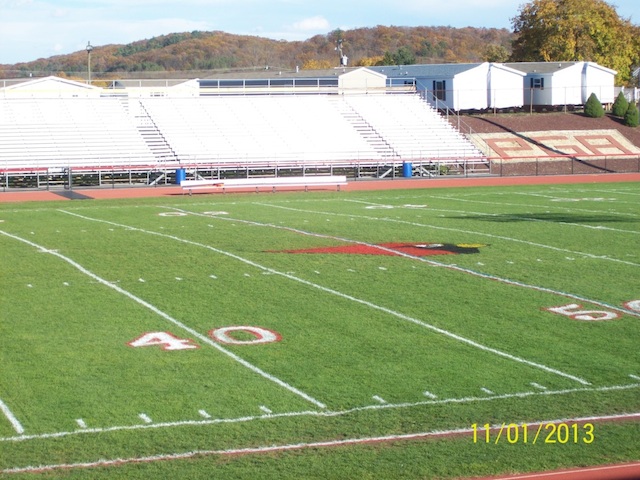We asked turf managers from different regions in the country how they keep turf cover deep into their football seasons. Here are some good responses:
Keith Lehman, Pine Grove Area SD (PA)
I always felt the key was to have the turf stand as healthy as possible going into the season and that process starts the day after the last event the previous fall. It is an ongoing cycle. I feel core aeration after the fall season and in early spring, if possible, combined with proper mowing practices to promote a thick stand, irrigation when necessary to promote deep rooting, a solid fertilizer maintenance program including weed and insect control are all important.
As Dr. Andrew McNitt says, “seed – seed – seed” to keep a high percent of living turf between those hashmarks.
I do not screen drag the cores in the fall aeration process but will include seeding, fertilizing and screening in the spring process. We maintain our athletic field turf height 2-3 times per week during the main growing season and do not want excessive clippings on the stand after mowing. If necessary a second opposite direction cut will be completed. When irrigation is necessary it’s a deep watering. Soil test results every 3-4 years is critical in putting together my fertilizer program.
Observation while mowing assists me when determining to include weed and insect control in the program. Seeding takes place during the spring aeration process if completed or I will spot seed with compost coverage. I also try to seed between the hash marks before every Friday night football game. Add these maintenance practices to some “good luck” that the scheduled events take place that will permit recovery and that events do not take place during excessive moisture conditions. Include pride when performing your duties and there should still be green between the hashes in November.
Marcus Dean, CSFM, University of Kentucky
On our practice football fields we cover with growth tarps from CoverSports between the hashes every Friday once games start. We leave them covered from Friday afternoon after practice until Monday morning. I get my entire crew to stay every Friday to help complete this task. On the stadium field we used to use the same type covers based upon weather, but now it is synthetic turf, so I don’t need to worry about that anymore.
Rich Watson, Pine Hill Public Schools (NJ)
I am not sure there is one simple answer to this question. Over the years there were many different ways to keep turf between the hash marks on our football fields. One thing I would consider is to try and communicate with the user groups and attempt to set some limits on non-game activities. For example, try to convince the coaches that it would really help field conditions if they could move their Thursday or Friday walkthrough to the practice field.
The day before “walkthrough” usually turns into a 2-hour or more practice with multiple series of plays run from the same spot on the field. The fact that they are in shorts and helmets may bring some relief to the players but doesn’t help the field. Any cooperation you can get from the user groups will help keep turf in the middle of your field.
While my first suggestion depends on the cooperation of others, heavily overseeding from the first time the cleats touch the turf through the end of the season is something anyone can do. It has been my experience that the only way to keep up with wear is to continuously seed. Broadcasting seed between the hash marks before practice or games will allow the players to work the seed in for you and hopefully allow germination before the next major event. Of course there are a lot of variables that come into play when seeding like this but for those of us in the north, football season is the best time of year to seed. Heavily seeding your “field within the field” will go a long way to help keep turf there all season long.
Peter Thibeault, CSFM, Noble & Greenough School (MA)
To keep turf between the hashes you need to keep going all year. Most of our prep starts in June after graduation and when lacrosse ends. We will go in and core aerate in three directions with a heavy overseed blend that is 50% bluegrass and 50% perennial ryegrass. Our seed rate down the middle is @ 10lb/1,000 sq. ft.
I will also core aerate and heavy overseed again at the beginning of August; the field is used all summer for day camp, which is around 1,000 little kids so the field gets very little rest and the work needs to be finished early.
During the season we will monitor compaction and aerate as needed to maintain optimum growing conditions. We overseed throughout the season to help replace worn turf, and in late September we will start to use a straight perennial ryegrass blend to give quick cover. We follow a fertility program that is based off our soil tests and turf needs. We have started to add silica, which is a blend of silicon, calcium and other micros that help the turf perform better during the stress of the summer heat and the stress of the athletes.
To manage the space between the hashes you almost have to look at that area as a completely separate space. Oh, and we do have a synthetic but that is for field hockey and lacrosse; soccer and football do not want to be on it unless they absolutely have to.


